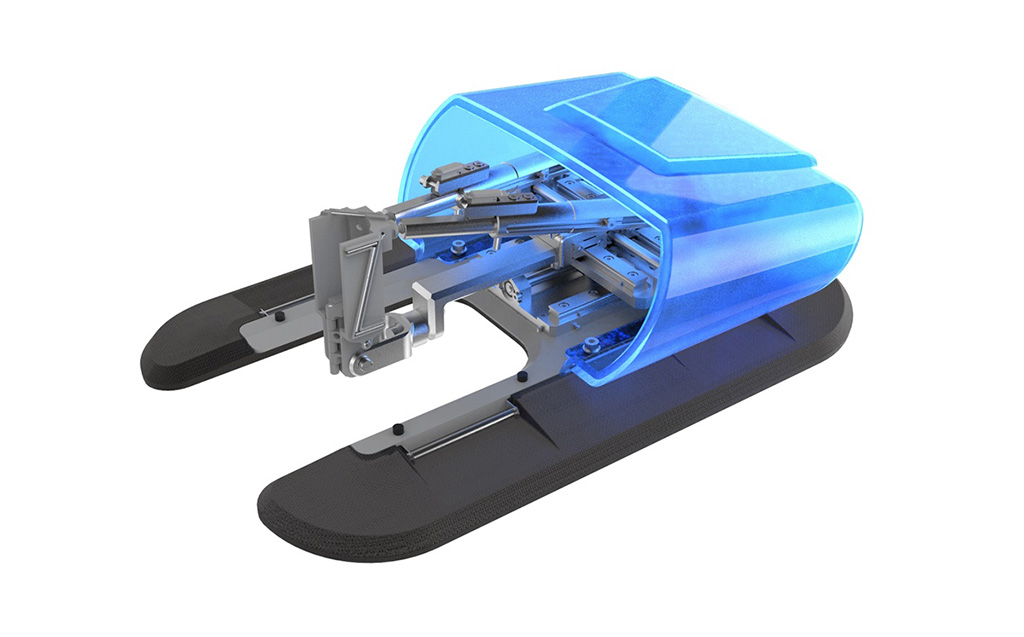Robotic Surgery System Guides Needle-Based Procedures
|
By HospiMedica International staff writers Posted on 12 Nov 2019 |

Image: The XACT Robotics needle trajectory system (Photo courtesy of XACT Robotics)
A hands-free robotic surgery system uses image-based planning tools and navigation systems to insert and steer various instruments to a desired location within the body.
The XACT Robotics (Caesarea, Israel) is a novel, patient-mounted, five degrees-of-freedom robot designed to facilitate predictable delivery of needles and various other instruments to a desired target within an accuracy range of within 1.5 millimeters, with concomitant planning of the proposed needle path. Once the desired target and the proposed trajectory are confirmed, the XACT technology assures hands-free insertion and steering, while at the same time compensating for any instrument deviation. In addition, the needle path can be adjusted without reinserting it or repositioning the patient.
The technology also compensates for breathing and patient movement intraoperatively, contributing to a predictable and safe performance that minimizes procedure duration. Additional features include a small footprint, high mobility, and ease of use, which enable care providers to treat a broad range of patient care needs in various clinical sites of service. XACT technology is designed to be compatible with a broad range of imaging modalities, including computerized tomography (CT)-guided percutaneous interventions, tissue biopsies, abscess drainage, or ablations.
“We are committed to redefining the way the entire medical community utilizes robotics, beginning with interventional radiologists,” said Harel Gadot, founder, executive chairman, and president of XACT Robotics. “Being the first to introduce a hands-free robotic system, we have the potential to provide significant clinical, technical and economic value while democratizing interventional procedures. Our system’s small footprint and high mobility design will enable care providers to treat a broad range of patient care needs in various clinical sites of service.”
“The XACT Robotic System provides a unique platform to the interventional radiology community which can help improve the delivery and quality of care for the patients we serve,” said Professor Nahum Goldberg, MD, director of the Applied Radiology Research Lab at Hadassah Hebrew University Medical Center (Jerusalem, Israel). “Based on our experience with this unique robotic technology, we can reach very small targets with unprecedented accuracy. Furthermore, this system holds much promise for enabling more efficient use of time and hospital resources.”
Related Links:
XACT Robotics
The XACT Robotics (Caesarea, Israel) is a novel, patient-mounted, five degrees-of-freedom robot designed to facilitate predictable delivery of needles and various other instruments to a desired target within an accuracy range of within 1.5 millimeters, with concomitant planning of the proposed needle path. Once the desired target and the proposed trajectory are confirmed, the XACT technology assures hands-free insertion and steering, while at the same time compensating for any instrument deviation. In addition, the needle path can be adjusted without reinserting it or repositioning the patient.
The technology also compensates for breathing and patient movement intraoperatively, contributing to a predictable and safe performance that minimizes procedure duration. Additional features include a small footprint, high mobility, and ease of use, which enable care providers to treat a broad range of patient care needs in various clinical sites of service. XACT technology is designed to be compatible with a broad range of imaging modalities, including computerized tomography (CT)-guided percutaneous interventions, tissue biopsies, abscess drainage, or ablations.
“We are committed to redefining the way the entire medical community utilizes robotics, beginning with interventional radiologists,” said Harel Gadot, founder, executive chairman, and president of XACT Robotics. “Being the first to introduce a hands-free robotic system, we have the potential to provide significant clinical, technical and economic value while democratizing interventional procedures. Our system’s small footprint and high mobility design will enable care providers to treat a broad range of patient care needs in various clinical sites of service.”
“The XACT Robotic System provides a unique platform to the interventional radiology community which can help improve the delivery and quality of care for the patients we serve,” said Professor Nahum Goldberg, MD, director of the Applied Radiology Research Lab at Hadassah Hebrew University Medical Center (Jerusalem, Israel). “Based on our experience with this unique robotic technology, we can reach very small targets with unprecedented accuracy. Furthermore, this system holds much promise for enabling more efficient use of time and hospital resources.”
Related Links:
XACT Robotics
Latest Surgical Techniques News
- New Transcatheter Valve Found Safe and Effective for Treating Aortic Regurgitation
- Minimally Invasive Valve Repair Reduces Hospitalizations in Severe Tricuspid Regurgitation Patients
- Tiny Robotic Tools Powered by Magnetic Fields to Enable Minimally Invasive Brain Surgery
- Magnetic Tweezers Make Robotic Surgery Safer and More Precise
- AI-Powered Surgical Planning Tool Improves Pre-Op Planning
- Novel Sensing System Restores Missing Sense of Touch in Minimally Invasive Surgery
- Headset-Based AR Navigation System Improves EVD Placement
- Higher Electrode Density Improves Epilepsy Surgery by Pinpointing Where Seizures Begin
- Open-Source Tool Optimizes Placement of Visual Brain Implants
- Easy-To-Apply Gel Could Prevent Formation of Post-Surgical Abdominal Adhesions
- Groundbreaking Leadless Pacemaker to Prevent Invasive Surgeries for Children
- Spectroscopy Technique Improves Surgery for Pediatric Epilepsy Patients
- Bioengineered Arteries Show Promise for Cardiovascular Surgery
- Online Tool Guides Surgical Decisions for Gallbladder Cancer
- Innovative Technology Enables Rapid Life-Saving Surgical Leak Detection
- First-Of-Its-Kind Bioresorbable Implant to Help Children with Rare Respiratory Disease
Channels
Critical Care
view channel
AI-Powered, Internet-Connected Medical Devices to Revolutionize Healthcare, Finds Study
A new study suggests that artificial intelligence (AI)-powered, internet-connected medical devices have the potential to transform healthcare by enabling earlier detection of diseases, real-time patient... Read more
Starfish-Inspired Wearable Tech Enables Smarter Heart Monitoring
Physical movement can make it challenging for current wearable devices to accurately track heart activity. Now, a starfish’s five-arm shape has helped resolve this issue. Inspired by the starfish's ability... Read morePatient Care
view channel
Portable Biosensor Platform to Reduce Hospital-Acquired Infections
Approximately 4 million patients in the European Union acquire healthcare-associated infections (HAIs) or nosocomial infections each year, with around 37,000 deaths directly resulting from these infections,... Read moreFirst-Of-Its-Kind Portable Germicidal Light Technology Disinfects High-Touch Clinical Surfaces in Seconds
Reducing healthcare-acquired infections (HAIs) remains a pressing issue within global healthcare systems. In the United States alone, 1.7 million patients contract HAIs annually, leading to approximately... Read more
Surgical Capacity Optimization Solution Helps Hospitals Boost OR Utilization
An innovative solution has the capability to transform surgical capacity utilization by targeting the root cause of surgical block time inefficiencies. Fujitsu Limited’s (Tokyo, Japan) Surgical Capacity... Read more
Game-Changing Innovation in Surgical Instrument Sterilization Significantly Improves OR Throughput
A groundbreaking innovation enables hospitals to significantly improve instrument processing time and throughput in operating rooms (ORs) and sterile processing departments. Turbett Surgical, Inc.... Read moreHealth IT
view channel
Printable Molecule-Selective Nanoparticles Enable Mass Production of Wearable Biosensors
The future of medicine is likely to focus on the personalization of healthcare—understanding exactly what an individual requires and delivering the appropriate combination of nutrients, metabolites, and... Read more
Smartwatches Could Detect Congestive Heart Failure
Diagnosing congestive heart failure (CHF) typically requires expensive and time-consuming imaging techniques like echocardiography, also known as cardiac ultrasound. Previously, detecting CHF by analyzing... Read morePoint of Care
view channel
Handheld, Sound-Based Diagnostic System Delivers Bedside Blood Test Results in An Hour
Patients who go to a doctor for a blood test often have to contend with a needle and syringe, followed by a long wait—sometimes hours or even days—for lab results. Scientists have been working hard to... Read more
Smartphone-Enabled, Paper-Based Quantitative Diagnostic Platform Transforms POC Testing
Point-of-care diagnostics are crucial for public health, offering rapid, on-site testing that enables prompt diagnosis and treatment. This is especially valuable in remote or underserved regions where... Read moreBusiness
view channel
Expanded Collaboration to Transform OR Technology Through AI and Automation
The expansion of an existing collaboration between three leading companies aims to develop artificial intelligence (AI)-driven solutions for smart operating rooms with sophisticated monitoring and automation.... Read more


















